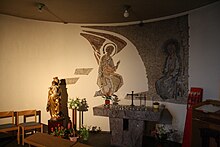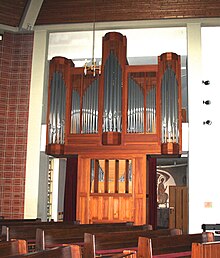Holy Spirit Church (Stade)
The Roman Catholic Holy Spirit church in Stade was built in the years 1959-60 and on the second day of Pentecost (June 6) in 1960 by the Hildesheim Bishop Heinrich Pachowiak consecrated . The design and execution were shared by Oberregierungsbaurat Paul Wolters , Hanover , and architect Hildegard Buttge , Stade. The interior was redesigned in 1985 and adapted to the requirements of the post-conciliar liturgical reform. The artistic design was in the hands of the sculptor Josef Baron from Unna . The parish belongs to the Deanery Lower Elbe of the Diocese of Hildesheim .
Building description
The tent shape of the church with the heptagonal room (symbolizing the seven gifts of the Holy Spirit) provided the suitable framework for this. (“See the tent of God among men” ( Rev 21,3 EU )). The center is the round altar , which extends far into the middle of the church, i.e. H. exactly under the top of the tent roof. The congregation no longer gathers in front of the altar as it used to, but forms a community around the altar. The new arrangement of the pews in the semicircle emphasizes this community character.
Interior
Altar and Tabernacle
The material of the altar is French Savonnières , a light limestone. The artist attached great importance to the fact that the altar was not placed on the finished floor, but embedded in it and thus grew out of the ground like a rock. It should symbolize strength and load-bearing capacity. The round shape is - like a ring - a symbol for the infinite and absolute. The motif of the face of the altar - grapevine and branches - reminds us of our bond with Christ. ("I am the vine, you are the branches. Whoever stays in me and in whom I stay, brings rich fruit ..." ( Joh 15,5 EU )).
The latticework of the back wall of the altar with the tabernacle takes up the medallion shape several times. Despite the height of five meters and the width of four meters, the work of art appears light and permeable. Buds and flowers surround the tabernacle and medallions. They are signs of developing and flourishing life. Buds and flowers can also be found on the other bronze works: on the candlesticks in the chancel, on the Easter candlestick, on the baptismal font and on the railings at the exit to the crypt . The theme of the tabernacle latticework is God's plan of salvation.
The tabernacle itself is the center of the bronze relief, outwardly highlighted by the brightly polished bronze. The beginning of the history of salvation is shown on the tabernacle doors, the Annunciation of the Archangel Gabriel to Mary. This representation is the starting point for viewing the relief. In the images on the six medallions, Christ fulfills God's plan of salvation. He gives himself up to suffering.
- 1st medallion (bottom left)
- On the Mount of Olives: An angel gives Jesus the cup of suffering.
- 2nd medallion (left center)
- The washing of the feet: Jesus came to serve.
- 3rd medallion (top left)
- The Lord's Supper: Jesus gives himself to his disciples.
- 4th medallion (bottom right)
- The mockery: Jesus is put the crown of thorns on his head.
- 5th medallion (right center)
- Before Pilate: Jesus is condemned to death.
- 6. Medallion (top right)
- It is done: an angel catches the instruments of suffering in a net and carries them to heaven.
The 6 medallions frame the central event, which is shown in the middle of the bronze relief: the crucifixion and resurrection of the Lord. Under the cross on the left we see Mary , Mother of the Lord, who at the same time, as mother of the Church, carries the book of the Old Testament. Next to her is depicted Mary Magdalene , who embraces the body of the crucified. On the right we see the disciple John carrying the book of the New Testament. The risen Lord appears above the cross, who still holds the shrouds in his hand and is accompanied by two adoring angels. Above him the hands of God the Father send out the spirit in the form of a dove. Thus the events experienced by Jesus in the light of the Holy Spirit are interpreted as the fulfillment of God's plan of salvation. ("Father, I have glorified you on earth and completed the work you asked me to do ..." ( Jn 17.4 EU )).
Ambo
In contrast to the sediles, the ambo has a fixed and immovable place in the sanctuary and thereby emphasizes the weight of the word of God that is proclaimed by him. It is made of bronze and shows in a large medallion the representation of the Pentecostal miracle, as it is handed down to us in the New Testament: The Holy Spirit comes down on the young church in the form of tongues of fire, i.e. H. to the disciples and to Mary, Mother of the Church.
Easter candlesticks
The Easter candlestick forms another distinctive point in the chancel. It reaches a height of 1.36 meters and presents the essential stages from the life of Jesus in three stages. Viewed from bottom to top:
- Nativity (Mary with the child, adoration of the three kings)
- Death of Christ (crucifixion group with soldiers)
- Resurrection of Christ (Christ with shrouds, angels)
The conclusion is the Easter candle itself, the symbol of the risen Christ.
Baptismal font
The baptismal font is like the other works of art made of bronze manufactured and also has his place in the sanctuary. It is 1.30 meters high and shows motifs from the Old and New Testament that indicate baptism .
- The face of the water container:
passage of the people of Israel through the Red Sea and destruction of the Egyptian armed forces,
water streaming out of the rock, the burning bush - The surface of the water container:
the symbols of the 4 evangelists, buds and flowers as in the other bronze works. - The hinged lid:
waves and a net with fish, the handle of the lid is shaped like a snake.
On the right side of the chancel, a staircase leads to the crypt (lower church). There a boulder serves as an altar, a stone that was found during the construction work. The back wall of the altar is decorated with two sgraffitos . They show Saint George and the Archangel Michael fighting the dragon. The stained glass windows (1982) were designed by the painter Josef Nienhaus from Ahaus , as well as the windows in St. Josef Church in Stade .
Mosaic in the side chapel
The mosaic in the side chapel was designed in 1962 by the artist Ludwig Baur from Telgte (1904–1977). It depicts the Annunciation scene. The window in the Lady Chapel was also designed by this artist.
14 stations of the cross and entrance doors
The 14 stations of the cross made of terracotta were made in 1968 by the artist Karl Zwernemann from Essen-Haarzopf.
The entrance doors of Jakob Riffeler's church , Köttingen, stamped in copper , show representations from the New Testament, as well as scenes from the lives of St. Nicholas and St. George.
organ
The organ by Gebr. Hillebrand (Isernhagen) from 1987 is a slider-drawer instrument with mechanical action and register action in a larch wood case. In the technical conception, the construction principles of the "North German Baroque Organ" have been consistently applied.
The organ has 23 registers with a total of 1650 pipes, namely 1620 metal pipes, which were made from different tin-lead alloys, and 30 pipes made of oak wood. The largest of the pipes is 2.90 m long, the smallest is 1.8 cm long in the body.
Five reeds are characteristic of the organ .
The disposition was designed in such a way that compositions of different stylistic epochs can be played on this organ.
|
|
|
||||||||||||||||||||||||||||||||||||||||||||||||||||||||||||||||||||||||||||||||
- Coupling : II / I, I / P, II / P
See also
literature
- Renate Kumm: The Diocese of Hildesheim in the post-war period. Investigation of a diaspora diocese from the end of the Second World War to the Second Vatican Council (1945 to 1965). Hahnsche Buchhandlung Verlag, Hanover 2002, pp. 144–151
Web links
Coordinates: 53 ° 35 ′ 19.1 ″ N , 9 ° 28 ′ 26.1 ″ E





